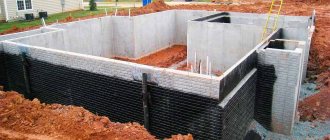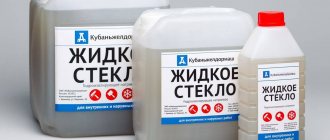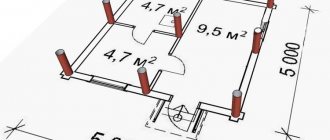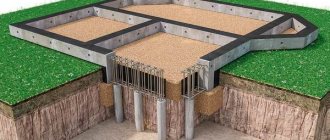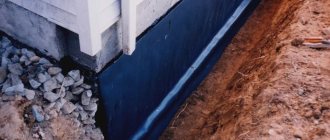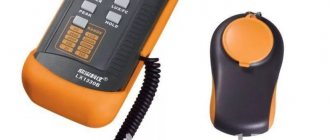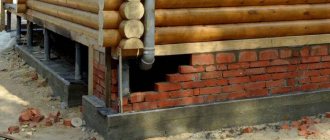Features and purpose
Due to the fact that the coating insulation is applied in a liquid state to the surface to be treated, all pores of the coated material, cracks and other damage are sealed, and the surface is covered with a monolithic protective film.
The film has sufficient elasticity that allows it not to collapse during seasonal temperature fluctuations; in its physical characteristics it is close to rubber.
Coating insulation is used in the construction of:
- foundations of various types;
- building plinths and their treatment both inside and outside;
- floors and walls of basements;
- any surfaces in contact with the ground;
- assemblies of door and window openings;
- pools and roofs.
Pros and cons of coating waterproofing
The advantages and disadvantages of this type of waterproofing are determined by the physical properties of the materials used and the technology for their implementation.
The advantages of coating waterproofing are:
- Low cost.
- High adhesion rates (ensuring contact between the surface and the material used).
- Ease of work (application to the surface to be treated).
There are a few more disadvantages, these are:
- when applied to the surface to be coated, it requires careful preparation (cleaning from dust and dirt, sealing cracks and other damage);
- work must be carried out at positive ambient temperatures and in the absence of precipitation (for external work);
- limited service life (5 – 6 years);
- when using bitumen and bitumen-containing mastics, they need to be heated, which increases labor costs for performing such work, and the use of open fire is a potentially fire hazardous event;
- When the surface treated with coating insulation is deformed, as well as other external influences, the waterproofing layer peels off.
Advantages and disadvantages of coating waterproofing
Protecting the foundation from soil moisture and groundwater using special liquid compounds is the most effective way. However, this type also tends to have its pros and cons.
The following can be noted as advantages:
- The protective layer is applied quite simply. In this case, the work can be carried out independently without the involvement of qualified specialists.
- The price of this type of waterproofing is affordable for most consumers.
Among the disadvantages, you should pay attention to the following points:
- The use of bitumen compounds without specific additives leads to a decrease in the quality of waterproofing. In some cases, such waterproofing begins to crack and peel off when the temperature drops slightly.
- When the foundation is destroyed or deformed, the waterproofing layer is destroyed.
Materials for coating waterproofing
To install coating waterproofing of foundations, special bitumen-based mastics, bitumen, cement-based compositions, and polymer materials are used.
Materials containing bitumen
In this group of waterproofing materials, bitumen comes first, but since... When using it, it requires heating, then due to the advent of new materials, its use is reduced.
Solid bitumen will need to be heated before application.
Various plasticizers (rubber, silicone) and sealants are added to the composition of bitumen-based mastics, which improves their physical properties, performance characteristics, as well as the conditions for performing work using them. Bitumen-polymer mastics do not require preheating, but before applying them it is necessary to treat the surface to be coated with a special composition - a primer primer.
Primer for bitumen mastic
Primer - primer is applied to improve adhesion, strengthen the treated base and close pores on its surface. Primer primers are manufactured on mineral, bitumen, alkyd and acrylic bases and for various types of bases (concrete, brick, wood, etc.).
Mastics are produced as one-component ones, which can be used without additional preparation, and two-component ones, which require preparation for use.
For different types of bases, different brands of mastics are produced: for foundations and floors, under tiles, for roofing, as well as for parts of buildings and structures in contact with the ground.
Bituminous mastic that does not require heating
Cement based materials
Cement-polymer mastics include Portland cement, mineral fillers and polymerizing additives. These are two-component formulations, the preparation of which requires water or a special emulsion.
In addition, the industry produces mixtures that, in addition to cement, contain resins and inert fillers, as well as organic additives.
These materials are somewhat more expensive than those made on the basis of bitumen, but due to the fact that when performing work using them, the total volume of construction and installation work is reduced, the total cost of construction is almost identical for both options.
The reduction in the amount of work is due to the fact that the cement-based waterproofing layer also serves as a screed for the final coating of the treated surface.
Polymer materials
This group of waterproofing materials includes mastics made from synthetic emulsions, rubber, plasticizers and other technological additives.
Polymer mastics are much more expensive than materials based on cement and bitumen, but due to their technological performance, which is significantly superior to these materials, they are becoming increasingly widespread.
The advantages of polymer materials are:
- High adhesion to the surface to be coated.
- Elasticity.
- Absolutely waterproof.
- Fire safety.
What is the best way to vertically waterproof a foundation?
This technology is much more diverse in terms of the materials used. Many of them are combined in systems, complementing each other. The options below can be adopted one at a time or several at once - it all depends on the construction conditions.
Bitumen treatment
The most inexpensive method is to coat the base with bitumen resin, which is sold in bars. Those who still don’t know what foundation waterproofing looks like and how best to do it should take into account an important detail. Preparation of the material for use and application technology is as follows:
- Pour 30% used oil and 70% bitumen into the container.
- Heat the composition over a fire or stove until liquid.
- Apply the liquid mixture to the cleaned surface of the base using a brush or roller.
- Coating in two or three layers begins from the base of the base.
The main disadvantage of this material is its short service life. Bitumen-polymer mastics are more durable. There are both cold and hot applied materials on the construction market:
- MBPH-100.
- Technomast from TechnoNIKOL.
- Elastopaz.
- Elastomix.
The method of applying the listed materials is different: with a spatula, roller or spray.
Processing of roll material
The option is used both separately and in combination with the coating method. Additionally, craftsmen recommend insulating and protecting the “pie” using, for example, cement-bonded particle boards or ACL.
The most affordable is roofing felt, but before installation it is treated with bitumen mastic, as in the previous method. Manufacturers also offer more modern products:
- Glass insulation
- Technoelast Barrier.
- Rubitex.
- Gidrostekloizol.
- TechnoNIKOL.
Polyester, which is the basis of the listed products, improves wear resistance and elasticity, which qualitatively improves the waterproofing of the monolithic foundation of a residential building or cottage.
Treatment with liquid rubber
An analogue of adhesive waterproofing can be called liquid rubber. It is also durable and has good adhesion. The main advantage of this treatment is the absence of seams on the surface. For independent implementation of a hydrophobic system, one-component mixtures Elastopaz or Elastomix are suitable.
The base must first be cleaned and primed. After the rubber has dried, you may need additional protection from stones and other construction debris that gets into the trench after it is backfilled. In this case, the base should be covered with DSP or geotextile.
Penetrating waterproofing
This category of water repellents includes compounds that can penetrate a concrete structure to a depth of 10-20 cm and crystallize inside. This prevents capillary penetration of moisture into the concrete. Corrosion reinforcement frame is also eliminated. Practice has shown the most effective mixtures, which, subject to technology, provide protection for up to 20 years:
- Penetron.
- Aquatron-6.
- Hydrotex.
Screen waterproofing of the base
The method is actually a modern analogue of a clay castle. The main material is bentonite mats based on the same clay. They are mounted with an overlap of 150 mm using dowels. A concrete wall should be installed nearby to prevent the mats from swelling. The most famous products are represented by the following products:
- Isobent.
- Bentisol.
- Rosbent.
- Bento-Mat.
The option is not used so often because it requires significant financial costs.
Service life and technical characteristics
Each type and type of material used to perform coating waterproofing is characterized by certain technical characteristics that determine its use and purpose, as well as service life that is guaranteed to meet the requirements for them.
Bitumen-based materials
Characteristics of bitumen mastics:
- coating layer thickness – 4.0 – 5.0 mm;
- conditional strength – 0.2-0.5 MPa (kgf/cm2);
- adhesion strength to the base (concrete) – 0.3-0.4 MPa (kgf/cm2);
- water absorption (by weight) – no more than 0.5-1% during the day;
- ability to elongate at break – 100-300%;
- conditional viscosity – at least 15-30 seconds;
- softening temperature – more than 100°C.
- service life – 4.5 – 6 years.
Price for waterproofing
If we consider the cost of ready-made compositions for coating the base of a house, then the most expensive ones will be acrylic-based and polymer (from 120 rubles/m2), the average option is cement (from 90 rubles/m2) and the most economical bitumen (from 30 rubles/m2) m2).
Let's take a closer look at the cost of some ready-made trains in large cities:
| Manufacturer of waterproofing | Price in large cities for 1 kg, rub. | ||||
| Moscow | Kazan | Ufa | St. Petersburg | Nizhny Novgorod | |
| TechnoNIKOL | 120-130 | 125-135 | 130-135 | 120-139 | 120-135 |
| Lakhta | 135-145 | 130-140 | 135-140 | 130-140 | 135-145 |
| Waterstop | 140-150 | 135-145 | 140-155 | 135-145 | 140-150 |
| Slav | 135-145 | 130-140 | 130-140 | 130-140 | 135-145 |
| Knauf | 190-250 | 200-260 | 210-270 | 190-250 | 195-255 |
| Ceresit | 200-260 | 210-290 | 220-290 | 200-260 | 210-255 |
The price for work is on average the same everywhere and starts from 100 rubles/m2 and can reach 350 rubles/m2 (depending on the material).
If the question arises whether it is necessary to waterproof the foundation and which is better, then first of all, when choosing, you should start from the location of groundwater and the foundation design itself. The coating option is one of the simplest and you can do it yourself.
Coating waterproofing technology
Work on installation of coating waterproofing is carried out as follows:
- The foundation surface is being prepared for waterproofing work. Dirt, dust and foreign objects are removed. Sharp edges and protrusions are rounded, metal embedded parts are cleaned of corrosion, cracks and seams are puttied.
- The surface is treated with a primer primer, and the type of primer must correspond to the type of waterproofing material. For mastics made using organic solvents, primers with a similar solvent are used, and similarly for water-based compositions. Primer primers are applied to the surface using hand-held painting tools (brushes, rollers).
- After this, when using bitumen and bitumen-polymer mastics, bitumen varnish is applied, which will improve adhesion when applying the first layer of mastic to the base to be coated. The varnish is applied with a hand painting tool or using a spray gun, after which time is given to dry.
- While the varnish dries, the mastic is prepared. If these are bitumen-based mastics that require heating, then they are heated, and two-component ones are mixed in accordance with the instructions for their use.
- The first layer of mastic is applied, using either a hand-held painting tool or spatulas, depending on the consistency of the material. The corners are carefully coated.
- Mastics are laid in an even layer over the surface of the foundation. Time is given for the laid layer to harden. After the first layer of mastic has hardened, the subsequent ones (two, three) are laid in a similar sequence.
- To give strength to the waterproofing, it is reinforced. To do this, after applying the first layer, a layer of fiberglass or fiberglass is glued, which will ensure the safety of the waterproofing layer during seasonal deformation of the foundation.
- Bitumen, as a rule, is used when installing horizontal waterproofing when it is necessary to install a thick waterproofing layer. It is applied using wooden spatulas and leveled with stiff bristled brushes.
It is more convenient to apply thick mastic or bitumen with a spatula.
Coating waterproofing can act as an independent type of foundation treatment, serving to protect against moisture penetration, and also as an additional one when installing adhesive-type waterproofing.
In order for the building to last as long as possible, it is necessary to insulate the base and foundation from moisture during construction.
Waterproofing is the protection of part of the structure and surfaces from water; for the base, the procedure is carried out both inside and outside.
In addition to its main purpose, waterproofing helps save the building from other aggressive liquids, corrosion, and keeps materials intact.
Rules for waterproofing
There are certain rules that should be followed no matter what material you decide to use.
- First, thoroughly clean the surface, removing any dirt or old insulation, if any.
- Prepare the base thoroughly, repairing even small cracks or seams on the surface.
- In order for the material you have chosen to adhere to the surface as best as possible, it is necessary to dry it additionally.
- If a primer is used, it must be warmed up and applied in at least two layers - before applying each subsequent one, you must wait until the previous one has completely dried.
- If you are using penetrating materials for waterproofing, then you do not need a primer - you should moisten the surface.
- Before applying any insulating material, you must carefully follow the technology - do not be lazy to study the instructions included by the manufacturer with the material purchased for the work!
- After applying the insulation, the part of the base located below ground level must be covered with dry soil and a blind area must be constructed.
- To protect the upper part, which is located above ground level, it is recommended to create a protective coating from any finishing materials that match the exterior of the building.
Tools for work
It all depends on what type of insulation you plan to choose. Specifically, you may need the following tools and additional supplies:
- hammer, axe, crowbar and shovel;
- well sharpened knife;
- roulette;
- roller and brush - preferably the fibers are synthetic;
- spray;
- brush with metal bristles;
- dowels;
- putty mesh;
- perforator;
- primer mixture;
- putty mixture;
- gas-burner;
- a grinding machine with discs matching the coating (most often a diamond disc is used).
Naturally, you do not need all the tools and consumables listed - the specific set depends on what type of waterproofing you choose.
Why do you need to protect the foundation of your house from water?
Waterproofing the base helps reduce or completely eliminate the ingress of moisture onto parts of the building and keep building materials intact. The main task of the procedure is to preserve the integrity of the building’s foundation for as long as possible and prevent destruction due to exposure to temperatures.
It is noteworthy that waterproofing work can be carried out both in advance, during the construction process, and after its completion.
The plinth is the external protection of the foundation; it creates a level for the lower floor, guides the laying of walls, and allows for the creation of additional basement rooms.
Basement waterproofing is necessary for:
Preservation of the building, durability of the building. Groundwater can wash away building materials, causing cracks to appear under pressure. As a result, the entire structure will be in danger of collapse.- When building materials come into contact with the ground, they enter into a chemical reaction, wear out faster, and the service life of the structure is reduced.
- Getting into microcracks and free cavities of the base (and then into the foundation), water molecules expand under the influence of low temperatures. This leads to disruption of the integrity of materials and cracks.
- The protection prevents moisture from entering the interior. Otherwise, the basement or basement rooms become damp, mold and other problems appear, reducing comfort and making it uninhabitable. The fungus quickly invades other spaces and can be dangerous to the health of residents.
- There are a lot of salts in groundwater and stormwater. They are deposited on the base, weaken the building mixtures, and lead to delamination and destruction of the structure. Salts leave a white coating that changes the appearance of the house and artificially ages it.
Consequences of not insulating your home from moisture
The basement of the building is exposed to water from both the soil and the atmosphere. This is the wettest part of the building. The lack of waterproofing affects not only the foundation, but also the walls of the building.
What are the consequences of lack of basement waterproofing:
- If this part of the building is made of brick, it absorbs moisture very well. It rises from the ground up the structure and destroys it from the inside. Finishing materials (tiles, panels, etc.) split and fall off in pieces. The external attractiveness of the building is lost.
- Penetration of moisture into the walls threatens to damage the thermal insulation of the room (the insulation gets wet, begins to rot and collapse). Heating the house will become difficult and will require a lot of resources.
- Water penetrates the cracks in the concrete foundation, erodes it and destroys it. It’s good if the base mixture initially contains waterproofing elements, the appearance of cracks will be delayed for some time. But such a building will wear out faster.
- The concrete base also splits and is torn from the inside by moisture entering through the cracks. The reliability of the building is lost, traces of salt remain on the outer part, the paint falls off along with the plaster.
- It becomes impossible to stay or store anything inside the basement floor. Biological microorganisms are difficult to remove; they spread throughout all rooms, the first floor and walls of the house are especially affected.
Waterproofing the base must be done in three places: in contact with the foundation, with the ground and with the wall. Then the structure will be reliably protected.
Waterproofing various types of foundations
All types of foundations have their own characteristics. And in addition to the groundwater level, it is necessary to take into account the design features and structure. Let's take a closer look at each of them.
Coating a slab foundation
It is best to waterproof a slab or monolithic foundation with rolled materials, such as roofing felt. But this method cannot always prevent moisture from reaching the base of the house. When coating a slab foundation, a bitumen solution is mainly used. You can cover the slab with bitumen with a brush, but first level the surface. If it has large irregularities, then additional screeding is done. The screed can be insulated, so ultimately floors are subsequently laid directly on the foundation.
This is one of the simplest types of foundation waterproofing, but also the most expensive.
Coating strip foundation
The strip foundation is waterproofed with different types of coatings. Let's consider the device of those whose reviews are the most frequent and positive.
Bitumen coating
This is one of the cheapest waterproofing options. It protects the foundation well not only from groundwater, but also from capillary penetration of moisture into the structure. But in the presence of pressure water, bitumen waterproofing does not help, since it can withstand a pressure of no more than 2 m. This happens due to shear and tensile loads.
You can extend the service life of the coating by applying bitumen to a flat surface. Before application, the base of the house must be dried and the corners rounded. Mechanical damage to waterproofing is terrible, especially at sub-zero temperatures or backfilling of the pit. Since construction waste is often found in such soil. For protection, EPPS insulation (rolled geotextile) is used. Insulation must be laid along the entire perimeter of the foundation to the level of freezing of the ground. You can take inexpensive EPS, the main thing is that its density is not less than 170 g/m2.
You need to attach the EPS to the wall of the base of the house using a pressure brick. But this type requires a lot of expense and labor. To avoid damage, you can fill the pit with sand, then the waterproofing with bitumen needs to be protected only in the corners with sheets 200 mm wide. The consumption of such a composition will be on average 1.5 - 2 kg/m2
Application of TechnoNIKOL bitumen mastic
TechnoNIKOL is easily applied using a special sprayer or a regular brush. TechnoNIKOL composition can be applied directly to an unprepared surface, unless you first remove excess dust. TechnoNIKOL bitumen mastic is an expensive coating, but it is durable and easy to apply.
TechnoNIKOL bitumen mastic requires mandatory reinforcement with geotextile whose density is maximum 120-130 g/m2. Composition consumption is on average 0.8 kg/m2. The main advantages of TechnoNIKOL bitumen mastic are as follows:
- Foundations with the most complex shapes can be processed.
- It is easy to spray on a foundation located close to another building.
- Not afraid of too low temperatures.
- The foundation under the composition becomes waterproof, but continues to allow oxygen to pass through.
Coating with cement mortar
If the groundwater pressure is less than 20 m, cement coating can be used. This is applied in a layer of 25-35 mm. The cement mortar is ready-made, moisture-resistant with penetrating mineral additives: various chemical compounds + cement + quartz sand). Average consumption 1.7 kg/m2. The main advantages of such coating:
- Resistant to mechanical damage
- Tolerates high and low temperatures well
- Not afraid of fire
The main and biggest disadvantage is the high price.
Coating a columnar foundation
A pile or columnar foundation is made on a grillage. It is very difficult to treat a pile using the coating method, so it must be immediately filled with moisture-resistant concrete for groundwater with a head of more than 20 m W6 or more, for a lower head of grade W4.
If the piles are made from wooden pillars. Then initially they are treated with anti-corrosion impregnation and only after complete drying they need to be treated with bitumen mastic or bitumen.
It is worth noting that the groundwater level should not be lowered, since the tree will not rot only if it is completely in the water. When part comes into contact with moisture and the other with air, rotting cannot be avoided. It is better to take wood that is resistant to moisture: larch, aspen.
Basic rules for applying foundation waterproofing
- All work can only be carried out at temperatures above +5 degrees.
- After precipitation, waterproofing is applied no earlier than 5-6 hours later.
- The minimum application layer should be 3-4 mm.
- Depending on the material, the coating will take 9-12 hours to dry. During this period of time, the surface must be protected from the sun and precipitation.
- It is necessary to measure the surface before coating obliquely.
- The final coating should dry for 2-3 days.
- Use tools: brush, spatula or spray.
What materials are used, how to choose them correctly?
Materials for basement waterproofing differ in properties. The choice is made based on performance characteristics:
Polymer compositions . Their physical properties are similar to rubber; they are used more often on the outside, where the base comes into contact with the ground and the atmosphere.
Advantages: tolerates temperature changes well, does not crack in the cold, it is not necessary to clean the surface before application, they are inexpensive.
Mixtures and primers . These materials are able to penetrate into the deep layers of the base, making them considered the best option for porous concrete and brick. Used for internal and external work. Apply using painting supplies (brushes, rollers). The base with it becomes heat-resistant and is not susceptible to external influences.
It can only be applied at above-zero temperatures; before the procedure, you need to protect your respiratory system and exposed skin. The compounds are applied to the cleaned surface. For better penetration into concrete or brick, the surfaces are leveled.
- Coating, mastics . Cement-polymer based materials. It is applied from above to the base, suitable for any surface, no preliminary preparation is required. Disadvantage: bitumen-based waterproofing is short-lived and needs to be updated periodically. Based on cement and polymers, it lasts longer and tolerates temperature changes well.
- Rolls: roofing felt, roofing felt, film, membrane . They are convenient to use when laying the foundation. The material is left in reserve in a trench or hole, and then the base is covered with it. This way the entire base of the building is protected from water, even if it is very close. Rolled coverings can withstand the pressure of melt water, are inexpensive and environmentally friendly. The most popular option is “Izospan A base”. This waterproofing is capable of releasing vapors to the surface, maintaining fresh air inside the basement.
- Injections. This is a special type of basement waterproofing; the solution is injected into the surface. Such work is carried out exclusively by specialists; the method is effective if the waterproofing procedure has not been carried out in advance; it is more expensive than others.
- mixtures,
- coating,
- processing with polymer compounds.
A brick base requires waterproofing, since the porous material absorbs a lot of moisture and quickly collapses.
Suitable for:
This way the brick will retain its useful properties: breathability, heat retention and visual appeal. It is recommended to carry out the procedure in advance and begin preparing from the moment the foundation is laid.
Processing methods
There are two types: horizontal and vertical waterproofing. Horizontal waterproofing between the plinth and the foundation is necessary if the plinth is also the base of the wall. It protects against moisture penetration from the foundation above and preserves the integrity of the walls for a long time. If the base is a continuation of the foundation, the procedure is optional.
This can be done if the base of the building is made of:
- stone,
- bricks,
- blocks,
- Concrete products
If the base and foundation are a monolithic concrete or rubble concrete structure, it cannot be waterproofed horizontally.
The moisture protection on the basement floor must be connected to the base protection, the seam between them is treated with a torch or mastic. Rolled materials are used here: roofing felt or roofing felt.
How to waterproof a foundation: materials and methods
There are two methods to protect reinforced concrete from the harmful effects of moisture:
- Using special chemical additives to the concrete mixture. Such a base is not subject to destruction under the influence of moisture, but you cannot make a solution yourself - you need a special preparation method. Therefore, we will not consider this option here.
- Creation of an additional hydrophobic layer for waterproofing a monolithic foundation plane of a residential building using mastics, powders, roll or sheet material.
In construction, there are two types of waterproofing of the base: horizontal and vertical. The first option protects walls and ceilings from capillary penetration of moisture, and the second involves organizing a protective layer along the entire vertical plane of a monolithic slab, strip or pile base. Typically, both types are combined into one waterproof building system.
Important! A competent builder will provide protection from moisture even at the stage of building the basement. To do this, the formwork is covered with a layer of waterproofing material with an overlap of 3-5 cm, and only then the concrete solution is poured. The joints must be treated with bitumen mastic.
If for some reason it is decided to protect the foundation from moisture after its construction, then you can use the following materials:
- Coating – polymer and bitumen mastics or emulsions that are applied with a brush, spatula or spray.
- Pasting - sheet or roll waterproof material, installation of which is carried out using a gas torch or without.
- Plasters are mineral-cement compositions with additives that increase the degree of hydrophobia.
Insulating the horizontal planes of the plinth
One of the main purposes of this method is to provide walls with protection from moisture. To achieve this goal, dense roll material is usually used. The most budget-friendly option is roofing felt, which is laid in several layers coated with bitumen.
In modern times, the question of how to treat the foundation of a building for waterproofing is not particularly difficult. Modern insulators, for example, from the Technonikol line, are superior to traditional roofing felt in many respects. In such materials there is no base, and the high quality of the bitumen-polymer mixture increases its flexibility.
Additional measures: installation of a drainage system
If there is a high groundwater level and low soil permeability in the area, it becomes necessary to drain excess moisture into a separate well. The technology for implementing the system is as follows:
- Along the perimeter of the object, at a distance of 0.7 m from the base, you need to dig a trench 0.3-0.5 m wide. Its depth depends on the groundwater horizon.
- The slope of the trench is made towards the collecting tank.
- Lay geotextiles at the bottom of the trench, turning the edges 0.8-0.9 m onto its walls.
- Fill with crushed stone or gravel in a layer of 5-8 cm over the entire plane of the trench.
- Lay drainage pipes with a slope of 5 mm per linear meter.
- Fill the pipe with gravel in a layer of 20-30 cm, having first washed it out.
- Wrap the edges of the geotextile and fill the trench with soil.
The drainage system can also be installed after the construction of the building. Proper organization of the blind area is also of no small importance.
Technology of work from inside and outside
Comprehensive moisture protection is carried out inside and outside the base. External insulation is more important, since the threat here is higher; from the inside, water penetration into the surface of the base occurs during the operation of the room.
Horizontal installation
Rolled materials are laid on the foundation before laying the base. How to make a coating with your own hands:
- Level the surface, remove all debris, seal cracks and crevices with connecting material.
- Cover a flat surface with bitumen mastic.
- Lay out the roofing material evenly, pressing it tightly against the mastic. Keep the overlap approximately 20 cm; there should be no air under the coating layer.
- At the joints, melt the roofing material with a gas burner; the seams are tight, without holes.
Vertical coating
You will need: bitumen mastic, bitumen primer. Instructions:
clean the surface from dust and debris, level it;- walk over the surface with a primer (bitumen primer) so that the materials adhere successfully;
- when the primer has dried, apply the mastic evenly and uniformly - the first layer should dry completely;
- apply a second coat.
After about 10 years, mastic may crack under the influence of temperatures. It is necessary to monitor the condition and carry out repairs on time.
Vertical roll
Often the coating is combined with rolled masonry, so the waterproofing layer is more reliable. You will need: rolled roofing felt, mastic, primer.
Procedure:
- Clean and level the surface.
- Apply primer and wait until dry.
- Apply the first even layer of mastic.
- Before joining the roofing felt and mastic, heat the rolled material on a gas burner until soft. This way it will adhere better to the coating.
- Apply roofing felt overlapping and melt the seams using a torch. There should be no gaps left.
- For reliability, it is recommended to apply 2-3 layers of roofing felt. Treat all joints with a torch or mastic.
In an already built house, waterproofing can be laid on top. First you need to clean the surface and degrease it with a primer. After applying all the layers sequentially, cover the top with facing materials (tiles, bricks). Reliably process joints.
But more often they use injection waterproofing, which is carried out by professional construction teams. The solution is injected into the finished base, fills the cracks and hardens.
Internal using mixtures
Inside the base, mixtures and primers are often used. They penetrate into microcracks in the coating, harden there and prevent moisture from seeping through.
Instructions:
- Level the surface and degrease with primer.
- Moisten the surface for better penetration of the mixtures.
- Apply penetrating material.
The penetrating material is suitable for concrete plinth walls; an adhesive primer (concrete contact) is used.
For bricks, silicon-based compounds are used, applied with a roller or brush. If you plan to apply coating to the brick, you first need to plaster the surface.
Possible process errors and ways to eliminate them
Common mistakes:
- External waterproofing was not carried out in advance. To do this after construction, when damage has already begun, you will need to open up part of the soil to the base of the base and drain groundwater (if it has reached the surface). Next, clean the damaged surfaces and strengthen them with reinforcement and cement. Apply waterproofing and cover with facing materials (or paint).
- No stripping or priming. These important process elements should not be skipped. The fact that a mistake has been made will become known with the appearance of leaks or damage to the base. Waterproofing will need to be repeated on the finished structure.
- Selection of low-quality materials. The suitability and interoperability of materials must be considered in advance.
The result of errors is the appearance of cracks.
They are eliminated like this: the crack is cleaned from the inside with an iron brush and filled with primer. If the crevice is wide, bitumen mastic is used. Afterwards it is treated with cement until it dries, and waterproofing is carried out over the entire surface of the base.
Average prices for the country
The price depends on the type of work. Average cost of work in Russian cities:
| Type of work | Moscow, r/m2 | St. Petersburg, r/m2 | Regions, r/m2 |
| Vertical using roll materials, coating, penetrating | 650 | 600 | 500 |
| Injection | 4500 | 3400 | 3300 |
| Horizontal | 600 | 550 | 500 |
The final price depends on the complexity, volume, materials and qualifications of the workers.
Everything you need to know about building a basement can be found in this section.


